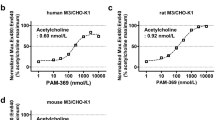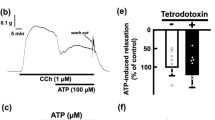Summary
The interaction of cholinergic agonists and antagonists with smooth muscle muscarinic receptors has been investigated by measurement of displacement of the muscarinic antagonist [3H]QNB (quinuclidinyl benzilate) in membranes prepared from toad stomach. The binding of [3H]QNB was saturable, reversible and of high affinity (K D = 423 pM). The muscarinic receptor subtypes present in gastric smooth muscle were classified by determining the relative affinities for the selective antagonists pirenzepine (M1), AF-DX 116 (M2) and 4-DAMP (M3). The results from these studies indicate the presence of a heterogeneous population of muscarinic receptor subtypes, with a majority (88%) exhibiting characteristics of M3 receptors and a much smaller population (12%) exhibiting characteristics of M2 receptors. The binding curve for the displacement of [3H]QNB binding by the agonist oxotremorine was complex and was consistent with presence of two affinity states: 24% of the receptors had a high affinity (K D = 4.7 nM) for oxotremorine and 76% displayed nearly a 1,000-fold lower affinity (K D = 4.4 μM). When oxotremorine displacement of [3H]QNB binding was determined in the presence GTPγS, high affinity binding was abolished, indicating that high affinity agonist binding may represent receptors coupled to G proteins. Moreover, pertussis toxin pretreatment of membranes also abolished high affinity agonist binding, indicating that the muscarinic receptors are coupled to pertussis toxin-sensitive G proteins. Reaction of smooth muscle membranes with pertussis toxin in the presence [32P]NAD caused the [32P]-labelling of a 40 kD protein that may represent the α subunit(s) of G proteins that are known to be NAD-ribosylated by the toxin. We conclude that both M3 and M2 receptors may be coupled to G proteins in a pertussis-sensitive manner.
Similar content being viewed by others
References
Akhtar RA, Hankanen RE, Howe PH, Abdel-Latif AA (1987) M2 muscarinic receptor subtype is associated with inositol trisphosphate accumulation, myosin light chain phosphorylation and contraction in sphincter smooth muscle of rabbit iris. J Pharmacol Exp Ther 243:624–632
Ashkenazi A, Winslow JW, Peralta EG, Peterson GL, Schimerlik MI, Capon DJ, Ramachandran A (1987) An M2 muscarinic receptor subtype coupled to both adenylyl cyclase and phosphoinositide turnover. Science 238:672–675
Benham CD, Bolton TB, Lang RJ (1985) Acetylcholine activates an inward current in single mammalian smooth muscle cells. Nature (Lond) 316:345–347
Birdsall NJM, Burger ASV, Hiley CR, Hulme EC (1978) The binding of agonists to brain muscarinic receptors. Mol Pharmacol 14:723–736
Christie MJ, North RA (1988) Control of ion conductances by muscarinic receptors. Trends Pharmacol Sci Suppl 30–34
Collins SM, Crankshaw DJ (1986) Dissociation of contraction and muscarinic receptor binding to isolated smooth muscle cells. Am J Physiol 251:G546-G552
de Jonge A, Doods HN, Riesbos J, van Zwieten PA (1986) Heterogeneity of muscarinic binding sites in rat brain, submandibular gland and atrium. Br J Pharmacol 89: 551P
De Lean A, Munson PJ, Rodbard D (1978) Simultaneous analysis of families of sigmoidal curves: application to bioassay, radioligand assay and physiological dose-response curves. Am J Physiol 235:E97-E102
Doods HN, Mathy MJ, Davidesko D, van Charldorp KJ, de Jonge A, van Zwieten PA (1987) Selectivity of muscarinic antagonists in radioligand and in vivo experiments for the putative M1, M2 and M3 receptors. J Pharmacol Exp Ther 242:257–262
Fisher SK, Heacock AM (1988) A putative M3 muscarinic cholinergic receptor of high molecular weight couples to phosphoinositide hydrolysis in human SK-N-SH neuroblastoma cells. J Neurochem 50:984–987
Giachetti A, Micheletti R, Montagna E (1986) Cardioselective profile of AF-DX 116, a muscarine M2 selective antagonist. Life Sci 38:1663–1672
Giraldo E, Monferini E, Ladinski H, Hammer R (1987) Muscarinic receptor heterogeneity in guinea pig intestinal smooth muscle: binding studies with AF-DX 116. Eur J Pharmacol 141:475–477
Giraldo E, Vigano MA, Hammer R, Ladinsky H (1988) Characterization of muscarinic receptors in guinea pig ileum longitudinal smooth muscle. Mol Pharmacol 33:617–625
Grider JR, Bitar KN, Makhlouf GM (1987) Identification of muscarinic M2 receptors on single cells of the human and guinea pig intestine. Gastroenterology 93:951–957
Hammer R, Giachetti A (1982) Muscarinic receptor subtypes: M1 and M2. Biochemical and functional characterization. Life Sci 31:2991–2998
Hammer R, Berrie CP, Birdsall NJM, Burgen ASV, Hulme EC (1980) Pirenzepine distinguishes between different subclasses of muscarinic receptors. Nature (Lond) 283:90–92
Hammer R, Giraldo E, Schiavi GB, Monferini E, Ladinsky H (1986) Binding profile of a novel cardioselective muscarinic receptor antagonist, AF-DX 115, to membranes of peripheral tissues and brain in the rat. Life Sci 38:1653–1662
Herawi M, Lambrecht G, Mutschler E, Moser U, Pfeiffer A (1988) Different binding properties of muscarinic M2-receptor subtypes for agonists and antagonists in porcine gastric smooth muscle and mucosa. Gastroenterology 94:630–637
Kerlavage AR, Fraser CM, Venter JC (1987) Muscarinic cholinergic receptor structure: molecular biological support for subtypes. Trends Pharmacol Sci 8:426–431
Kilbinger H, Nafziger M (1985) Two types of neuronal muscarine receptors modulating acetylcholine release from guinea-pig myenteric plexus. Naunyn-Schmiedeberg's Arch Pharmacol 328:304–309
Ladinsky H, Giraldo E, Monferini E, Schiavi GB, Vigano MA, De Conti L, Micheletti R, Hammer R (1988) Muscarinic receptor heterogeneity in smooth muscle: binding and functional studies with AF-DX 116. Trends Pharmacol Sci Suppl 44–48
Laemmli UK (1980) Cleavage of structural proteins during the assembly of the head of bacteriophage T4. Nature (Lond) 227:680–685
Lucchesi PA, Cooney RA, Mangsen-Baker C, Honeyman TW, Scheid CR (1988) Assessment of transport capacity of plasmalemmal Ca2+ pump in smooth muscle. Am J Physiol 255: C226-C236
McMahon KK, Hosey MM (1985) Agonist interactions with cardiac muscarinic receptors. Effects of Mg2+, guanine nucleotides and monovalent cations. Mol Pharmacol 28:400–409
Merritt JE, Taylor CW, Rubin RP, Putney JW Jr (1986) Evidence suggesting that a novel guanine nucleotide regulatory protein couples receptors to phospholipase C in exocrine pancreas. Biochem J 236:337–343
Micheletti R, Montagna E, Giachetti A (1987) AF-DX 116, a cardioselective muscarinic antagonist. J Pharmacol Exp Ther 241:628–634
Mitchelson F (1988) Muscarinic receptor differentiation. Pharm Ther 37:357–423
Munson PJ, Rodbard D (1980) LIGAND: A versatile computerized approach for characterization of ligand-binding systems. Anal Biochem 107:220–239
Nathanson NM (1987) Molecular properties of the muscarinic acetylcholine receptor. Ann Rev Neurosci 10:195–236
Pfeiffer A, Rochlitz H, Herz A, Paumgartner G (1988) Stimulation of acid secretion and phosphoinositol production by rat parietal cell muscarinic M2 receptors. Am J Physiol 254:G622-G629
Redinbaugh MG, Turley RB (1986) Adaptation of bicinchoninic acid protein assay for use with microtiter plates and sucrose gradient fractions. Anal Biochem 153:263–271
Ribiero-Neto F, Mattera R, Grenet D, Sekura RD, Birnbaumer L, Fields JB (1987) Adenosine diphosphate ribosylation of G proteins by pertussis and cholera toxin in isolated membranes. Different requirements for and effects of guanine nucleotides and Mg2+. Mol Endocrinol 1:472–481
Rinner I, Doods HN, van Charldorp KJ, Davidesko D, van Zwieten RA (1988) Binding of muscarine receptor antagonists to pig coronary smooth muscle. Naunyn-Schmiedeberg's Arch Pharmacol 337:146–150
Salmon DM, Honeyman TW (1980) Proposed mechanism of cholinergic action in smooth muscle. Nature (Lond) 184:344–345
Sims SM, Singer JJ, Walsh JV Jr (1986) A mechanism of muscarinic excitation in dissociated smooth muscle cells. Trends Pharmacol Sci (Suppl) :28–32
Takuwa Y, Takuwa N, Rasmussen H (1986) Carbachol induces a rapid and sustained hydrolysis of polyphosphoinositide in bovine tracheal smooth muscle. Measurements of the mass of polyphosphoinositides, 1,2-diacylglycerol and phosphatidic acid. J Biol Chem 261:14670–14675
Vivaudou MB, Clapp LH, Walsh JV Jr, Singer JJ (1988) Regulation of one type of Ca2+ current in smooth muscle cells by diacylglycerol and acetylcholine. FASEB J 2:2497–2504
Williams DA, Becker PL, Fay FS (1987) Regional changes in calcium underlying contraction of single smooth muscle cells. Science 235:1644–1648
Author information
Authors and Affiliations
Additional information
Send offprint requests to T. W. Honeyman at the above address
Rights and permissions
About this article
Cite this article
Lucchesi, P.A., Romano, F.D., Scheid, C.R. et al. Interaction of agonists and selective antagonists with gastric smooth muscle muscarinic receptors. Naunyn-Schmiedeberg's Arch Pharmacol 339, 145–151 (1989). https://doi.org/10.1007/BF00165136
Received:
Accepted:
Issue Date:
DOI: https://doi.org/10.1007/BF00165136




